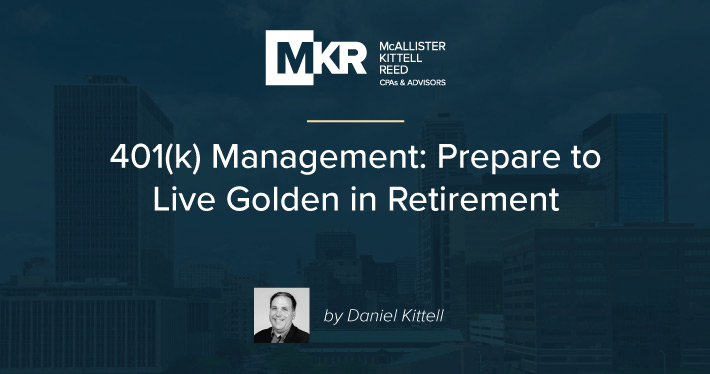“Set it and forget it” is a common approach when it comes to a workplace 401(k), yet it likely will play a substantial role in the financial security of your future. Consistently contributing to your 401(k), and learning how to manage it, will set you on the course to living golden in your retirement years. Below are some tips to help you make the most of your workplace 401(k).
Contribute to the Match
Employers often match contributions up to a certain point, which means you’re getting free money for participating in the program. You should contribute at least up to this point. Beyond this, a typical rule of thumb is to add about 15% to your 401(k) plan each year, including company contributions (i.e. if your company matches 3%, plan to contribute 12%).
Boost Your Investment Savvy
Expense Ratio? Risk Tolerance? Whether you’re going it alone or recruiting the help of a financial professional, you need to have a basic knowledge of investing. Before filing away the information sent to you by your plan, be sure to read through it and look up any terms you don’t understand.
Get Help with Account Management
Of course, having a basic understanding of investment terms will take you only so far. If your investment knowledge is shaky, it might be worth it to recruit the help of a professional. Some 401(k) plans even offer free advice from a professional, or they will provide model portfolios to follow.
Save with a Target Date Fund
The simplest approach to a 401(k) plan is to allocate savings to the target date fund with the date that corresponds to the year closest to the year you reach age 65. With this low maintenance approach, the fund automatically adjusts as you get closer to retirement.
Learn to Rebalance
If you’re not partaking in the target date fund, you will need to perform routine maintenance on your 401(k), which is what “rebalancing” means. Provided you have a mix of stocks and bonds, you will have to buy and sell assets as they move up or down in value. Generally, participants have the option to automatically rebalance through your plan’s website, typically with a quarterly or annual rebalancing.
Rethink Withdrawals
Though you may be able to take a loan from your 401(k), they usually have to be paid back within five years, with interest. The risks of borrowing from your 401(k) come when you lose your job or change employers, because the loan will be due almost immediately. If you can’t repay the loan, you’ll be taxed and burdened with a 10% penalty for early withdrawal. Not to mention, by taking out a loan on your 401(k), you are shortchanging your retirement savings in a way that could be extremely difficult to catch up.
Mix It Up
Your 401(k) should be only one prong in your retirement plan. Your home and other assets, funds from a side hustle, and other investment accounts like an IRA might be additional prongs that make a complete picture of your financial future. Spreading your assets over multiple income streams will yield better returns, so if you switch jobs at some point, consider whether rolling your 401(k) into your new employer’s plan makes the most sense for your situation, or if you should put those funds into an IRA, which may give your more investment options.


